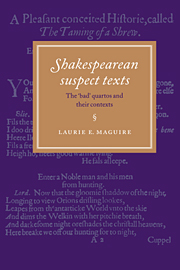4 - Reporting speech, reconstructing texts
Published online by Cambridge University Press: 19 October 2009
Summary
of our text,/You make a wronge construction
Heywood, 1 If You Know Not Me (1605) 78–9.evadne: where got you this report[?]
melantius: Where there was people[,] in euery place.
Beaumont and Fletcher, The Maid's Tragedy (1619) G4r,14–15Up to now my investigation of memorial reconstruction has concentrated on the twentieth century and the theories offered by textual critics to explain suspect texts. I now turn my attention to the sixteenth and seventeenth centuries, to ascertain what external evidence exists for invoking memory, reconstruction, and actors, independently or together, to explain suspect texts.
As we shall see, what evidence there is supports the theory that plays could be, and were, reconstructed from memory. However, the evidence suggests that the concept of play reconstruction is not a single sequence of processes with a single objective (reconstruction from memory by actors for the purpose of performance) but a variety of processes involving different kinds of agents (auditors, actors, or other playhouse personnel), different purposes (performance, publication, private transcript), and different combinations of memory and other aids to recall (longhand notes, shorthand notes, reports of narrative outline) often supplemented by new composition.
The brevity of this chapter testifies to the paucity of external evidence. The evidence, such as it is, is nonetheless complex, drawing on a wide range of genres, periods, and cultures. My departure point is not Elizabethan drama, but its parallel in terms of popular and edifying entertainment: church sermons.
- Type
- Chapter
- Information
- Shakespearean Suspect TextsThe 'Bad' Quartos and their Contexts, pp. 95 - 112Publisher: Cambridge University PressPrint publication year: 1996



